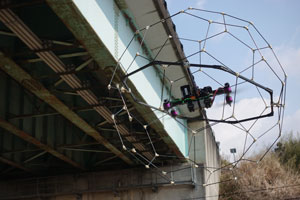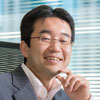Dec. 28, 2018 Perspectives Computing / Math
By Artificial Design
Japanese artificial intelligence researchers are working on deep-learning algorithms that glean advanced insights from Japanese types of data.
 Roughly 40 percent of Japan’s infrastructure will be 50 years old or older by the 2020 Tokyo Olympics. AI from RIKEN will help the Japanese government assess what needs to be fixed using drones. © 2018 Getty Images/Hidetsugu Mori/Aflo
Roughly 40 percent of Japan’s infrastructure will be 50 years old or older by the 2020 Tokyo Olympics. AI from RIKEN will help the Japanese government assess what needs to be fixed using drones. © 2018 Getty Images/Hidetsugu Mori/Aflo
Human wisdom is the result of accumulated experiences, and soon machines will be wiser too. Sound like science fiction?—It isn’t. Powerful artificial intelligence (AI) algorithms are already driving ‘deep learning’ programs that use complex pattern reinforcement so that machines can ‘learn’ from data. This technology will enhance human analytics so much that it could add US$3.5 trillion annually to the global economy, according to a report released in April 2018 by the McKinsey Global Institute.
The RIKEN Center for Advanced Intelligence Project (AIP) was set up in 2016, following extensive discussions with Japan’s Ministry of Education, Culture, Sports, Science and Technology on the best ways to invest in intelligent computing. I became the inaugural director, a role I took alongside a professorship at the Graduate School of Frontier Sciences at the University of Tokyo.
Even in the short time the AIP has been around, AI technologies—including speech recognition, image analysis and language interpretation—have made huge inroads, and the young AIP quickly established links with more than 50 academic groups and research teams.
However, researchers around the world are still working on AI capable of higher level thinking—machines that could, for example, interpret the underlying meaning of sentences in the context of a whole conversation. As a result, we’re still working closely with neuroscientists and psychologists on useful learning phenomena and behaviors that we could replicate within computer programs.
All of this work ties into the first of the AIP’s five main missions: to continue developing fundamental AI technologies, which will help AI move beyond working on well-defined data to being able to recognize patterns in more complex data.
Japan, it turns out, has to develop smarter algorithms. For a variety of reasons (including population and language), we don’t have access to the same amount of data as the USA and China, from where a lot of advances in AI research are emanating. We will have to develop smarter technology to be able to learn from limited information.
Fortunately, AI has recently moved on from being about better data or bigger computers. In 2017, David Silver, the principal researcher on Google’s highly publicized deep-learning project, Go, pointed out that today “it is the novel algorithms that really matter.” He made his point just after his team published a paper on a particularly game-changing algorithm, AlphaGo Zero1. It represented a huge leap forward for AI algorithms. Smart algorithms like AlphaGo Zero will hopefully have many additional advantages.
Japanese AI finds new drugs and solar materials
 The RIKEN Center for Advanced Intelligence Project (AIP) is helping assess the condition of infrastructure by using drones and AI-driven image analysis to spot cracks in hard to reach places. © 2018 RIKEN
The RIKEN Center for Advanced Intelligence Project (AIP) is helping assess the condition of infrastructure by using drones and AI-driven image analysis to spot cracks in hard to reach places. © 2018 RIKEN
This leads us to our second mission, which is to help accelerate and augment scientific research. Our AI software can already help scientists search through literature for relevant findings, and collate or summarize measurements across several papers.
Scientists today can also generate increasingly large datasets and use them to simulate phenomena such as the behavior of biological proteins or climate change, for which millions of calculations must be performed over large, fine-scale grids, taking up unwieldy amounts of computational power and time. We can help our computer science colleagues to streamline this process by providing software tools to help build models to limit the computing power needed to run simulations.
We have already had some great results assisting geoscientists simulating earthquakes, tsunamis and floods in collaboration with the RIKEN Center for Computational Science, which operates the supercomputer known as the K computer2.
Alongside this work, the AIP is helping to simulate complex chemistry and quantum physics to find
new functional materials for electronics and manufacturing. For example, in 2018 we applied this technology to finding molecules suitable for organic photovoltaic cells useful to solar technology, photofunctional sensors and ultraviolet filters, among other things3. By using a combination of known chemistry and deep learning, in 10 days a collaboration that included AIP was able to identify five synthesizable and stable organic molecules possessing target properties.
Perhaps our most active multidisciplinary efforts are in applying AI to medicine, including image analysis tools to extract information from x-rays, MRI scans and other imaging systems, as well as statistical software that helps biologists to understand the immense datasets generated by genomics, molecular biology, government surveys and clinical records. Deep learning machines interrogating these ‘big data’ sets help to produce fast diagnoses or can suggest relevant directions for research.
AIP teams are also applying similar algorithms to design drug compounds that can match up the shapes of disease-related proteins and neutralize them.
With about 15–20 percent of drug development costs seen in the discovery phase, this could soon be a huge boon to medicine. In the USA, for example, there is a program to show researchers how proteins fold to help them build drugs against various viruses that is already seeing heavy investment.
The Social benefits of AI: Everything From fixing bridges to wellbeing
Of course, we have a duty to focus on projects that will benefit society, and this is reflected in our third mission, which is to use AI to find solutions to critical domestic problems.
To this end, the AIP has been helping the Japanese government address the fact that roughly 40 percent of Japan’s infrastructure will be 50 years old or older by 2020, the year of the Tokyo Olympics. The total cost of Japan’s infrastructure, including its roughly 700,000 bridges and 100,000 tunnels, has been estimated at ¥700 trillion, so it seems logical to fix these structures rather than replace them. To do this, our AI is being used to control fleets of drones that will use various cameras to inspect hard-to-reach parts of bridges, and these will automatically identify cracks or other damage through image analysis.
As AI enters the practical world, ethical implications also become more important, and staying on top of this area is our fourth mission. Some people believe that AI will polarize people due to concerns about the loss of jobs and privacy. Data privacy is already contentious, with big companies being forced to restructure their business models as regulation tightens, most notably through the General Data Protection Regulation (GDPR) introduced by the European Union in May 2018.
As a result, we have dedicated teams investigating societal attitudes to AI, monitoring international information laws, and working to make sure that interactions between humans and machines are pleasant experiences.
Building talent and working alongside corporate R&D
However, all of these tasks are impossible if our fifth mission fails: Japan’s next generation of AI researchers and data scientists must be nurtured. Due to its structure, the AIP is lucky to have very broad academic links. For example, 35 out of the 51 team leaders at AIP are professors at other Japanese universities and we have ongoing partnerships with a number of institutions. We have also hosted more than 70 graduate students doing internships for periods ranging from a few months to a year.
While we find many of our talented students are enticed into jobs in Japan’s strong corporate R&D sector, we still have the chance to collaborate with them. Many multinationals already have collaboration centers with us, including Fujitsu, Toshiba, NEC and Fujifilm. Our projects include improving the efficiency of their manufacturing plants. And while these industrial research partners benefit from our fundamental research and software, we benefit from their wide range of resources and learn from their experiences of bringing AI into the real world.
References
- 1. Silver, D., Schrittwieser, J., Simonyan, K., Antonoglou, I., Huang, A. et al. Mastering the game of Go without human knowledge. Nature 550, 354–359 (2017). doi: 10.1038/nature24270
- 2. Ichimura, T., Fujita, K., Yamaguchi, T., Hori, M., Lalith, M. and Ueda, N. AI with Super-computed data for Monte Carlo Earthquake Hazard Classification.Proceedings of the International Conference for High Performance Computing, Networking, Storage and Analysis (2017).
- 3. Sumita, M., Yang, X., Ishihara, S., Tamura, R., and Tsuda, K. Hunting for organic molecules with artificial intelligence: Molecules optimized for desired excitation energies. ACS Central Science, published online 20 August 2018 doi: 10.1021/acscentsci.8b00213
About the Researcher
Masashi sugiyama

Masashi Sugiyama has been the director of the RIKEN Center for Advanced Intelligence Project (AIP) since it was set up in 2016. He is also a professor at the Graduate School of Frontier Sciences at the University of Tokyo, and was the first Asian program chair at the Neural Information Processing Systems (NeurIPS) conference in 2015. NeurIPS is the largest international conference in the machine learning field. In 2012, he published a book with The MIT Press, Machine Learning in Non-Stationary Environments.
